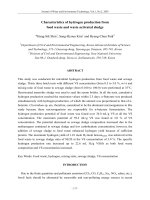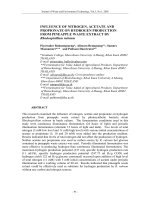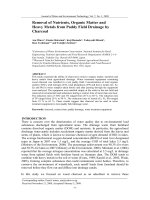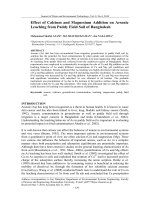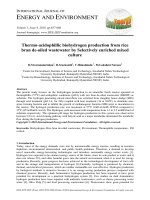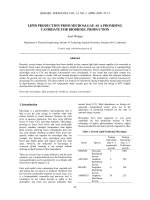Ethanol production from paddy straw using partially purified fungal cellulase
Bạn đang xem bản rút gọn của tài liệu. Xem và tải ngay bản đầy đủ của tài liệu tại đây (333.77 KB, 11 trang )
Int.J.Curr.Microbiol.App.Sci (2018) 7(8): 3709-3719
International Journal of Current Microbiology and Applied Sciences
ISSN: 2319-7706 Volume 7 Number 08 (2018)
Journal homepage:
Original Research Article
/>
Ethanol Production from Paddy Straw using Partially
Purified Fungal Cellulase
Monika Agarwal1, Annu Goel2* and Leela Wati3
3
Principal Scientist, 1Department of Microbiology, CCS Haryana Agricultural University,
Hisar-125 004, India
2
Research Associate, Central Pollution Control Board, Delhi 110032, India
*Corresponding author
ABSTRACT
Keywords
Agricultural wastes,
Bio-ethanol,
Cellulase,
Lignocellulosic,
Paddy straw.
Article Info
Accepted:
20 July 2018
Available Online:
10 August 2018
In an endeavour of exploring alternative energy sources to petroleum based fuels, bioethanol (ethanol derived from biomass) is considered as the most promising renewable fuel
because of its potential to cut greenhouse gas emissions by 86% and higher octane (ability
to resist compression) rating than gasoline. Present investigation was aimed at bioconversion of paddy straw to ethanol using partially purified fungal cellulases. A variety of
soil samples were tested for the presence of cellulolytic fungal strains using enrichment
culture technique. Fungal strains were selected based on the diameter of clearance zone on
carboxymethylcellulose (CMC) agar plates. Selected strains were tested for the cellulase
viz., exoglucanase and endoglucanase activities before and after partial purification. Out of
the 10 selected cellulolytic fungal isolates, F-1 isolate has the highest 0.42 IU/ml
exoglucanase and 1.66 IU/ml endoglucanase activities. Enzyme production was maximum
in Mandels and Sternberg medium containing delignified paddy straw as carbon source at
30°C after 7 days’ incubation with0.66 and 2.52 IU/ml exoglucanase and endogluanase
activities, respectively. Ammonium sulfate saturation at 50-55% followed by dialysis
resulted in the partial purification of crude cellulase enzyme with2.8 and 2.1 folds’
increase in exoglucanase and endogluanase activities, respectively. Hydrolysis of
delignified paddy straw using partially purified enzyme obtained from F-1 isolate resulted
in 63.7% solubilization of polysaccharide fraction at 50 0C after 4 h reaction time.
Introduction
Rapidly
depleting
fossil
fuels
and
environmental pollution have led to a
worldwide search for alternative fuels. Ethanol
can be used as fuel as gasohol in addition to
other applications in industries which need
production of alcohol on large scale. Many
efforts have been made in recent years to
enhance ethanol production from different
sources (Galbe and Zacchi, 2002). Molasses
based ethanol production is limited by the
production of sugarcane in the country. Bioethanol can be produced from other sugar
(from sugarcane) or starch (from maize,
cassava etc.) based feedstock but the choice of
3709
Int.J.Curr.Microbiol.App.Sci (2018) 7(8): 3709-3719
biological feedstock, environmental variables
and the organism determines the efficiency of
ethanol production process. Sugar and starch
rich food crops are an integral part of animal
and human food chain and as the global
population has increased their use in
producing bio-ethanol has been criticized for
diverting food away from the human and
animal food chain, leading to food shortage
and price rise (Goel and Wati, 2013).
The cheap and abundant sugar polymer, found
as agricultural wastes (wheat straw, corn
stalks, soybean residues, sugar cane bagasse
etc.) and industrial wastes (pulp and paper
industry) accounts for about 50% of the
biomass in the world (Classen et al.,
1999).Effective utilization of cellulosic
materials through bioprocesses will be an
important key to overcome the shortage of
fuels (Ohmiya et al., 1997). Paddy straw is
one of the most abundant lignocellulosic waste
materials in the world. In terms of total
production, rice is the third most important
grain crop in the world after wheat and
corn.High silica content of paddy straw makes
it unfit for animal feed and its disposal by
burning is banned due to air pollution causing
pulmonary morbidity and mortality (Binod et
al., 2010). The best alternative for handling
such a huge quantum of biomass is the
production of commercially important valueadded products like ethanol (Oberoi et al.,
2010).
The bioconversion of paddy straw to ethanol
is a multi-step process consisting of
pretreatment, hydrolysis and fermentation.
Without any pretreatment, the conversion of
native cellulose to sugar is extremely slow, as
cellulose is well protected by the matrix of
lignin and hemicellulose in macrofibrils.
Therefore, pretreatment of paddy straw is
necessary to increase the rate of hydrolysis of
cellulose to fermentable sugars (Galbe and
Zacchi,
2002).
The
cellulose
and
hemicellulose can be hydrolyzed to
fermentable sugars either by chemical or
biological means, the later employing
enzymes i.e. cellulases and hemicellulases
(Goel and Wati, 2013).The enzymatic
hydrolysis is preferred because of high
specificity, lower cost and purity of the end
products. Cellulases are usually a mixture of
several enzymes. Three major groups of
cellulases involved in the hydrolysis
processare: 1. endoglucanase, which attacks
regions of low crystallinity in the cellulose
fiber, creating free chain-ends 2. exoglucanase
or cellobiohydrolase, which degrades the
molecule further by removing cellobiose units
from the free chain-ends and 3. glucosidase,
which hydrolyzes cellobiose to produce
glucose glucose (Coughlan and Ljungdahl,
1988). Conversion of lignocellulosic biomass
to fermentable sugars mainly depends on the
degradation capacity of a range of biomassdegrading enzymes produced by many
cellulolytic microorganisms (Kovacs et al.,
2009). The lack of a microorganism able to
produce cellulase enzyme efficiently is one of
the limiting factors for utilization of
lignocellulosic wastes like paddy straw to
ethanol. The present investigation was,
therefore, carried out to isolate an efficient
cellulase producer fungal strain and
standardization of environmental variables for
maximum enzyme production followed by
partial purification of enzyme for efficient
polysaccharide hydrolysis of paddy straw for
ethanol production.
Materials and Methods
Soil samples for cellulolytic fungal isolates
were collected from various locations of
University farm of CCS HAU, Hisar and
nearby areas. Paddy straw of Pusa-1 variety
was procured from farmers’ fields and dried at
50°C. The standard culture of Trichoderma
reesei MTCC 3194 was obtained from
Institute of Microbial Technology (IMTECH),
3710
Int.J.Curr.Microbiol.App.Sci (2018) 7(8): 3709-3719
Chandigarh and maintained on Potato
Dextrose Agar slants containing potatoes
250.0; dextrose 20.0 and agar-agar 20.0 (g/L)
at 4±1oC. A fast fermenting yeast strain of
Saccharomyces cerevisiae HAU-1 was
procured from culture collection, Department
of Microbiology, CCS HAU, Hisar and
maintained on yeast extract peptone dextrose
agar slants containing dextrose 20.0; Yeast
extract 10.0; peptone 20.0 and agar-agar 20.0
(g/L) at 4±1oC.Commercial liquid cellulase
(Palkosoft super 720) was obtained from
MAPS India Limited, Ahmedabad, Gujarat.
Isolation and screening of
fungal strains
cellulolytic
Fungal strains for cellulase production
potential were isolated from soil using
enrichment culture technique in Mineral salt
medium (Mandels and Sternberg, 1976)
containing: Cellulose 10.0; Potassium
hydrogen phosphate 2.0; Ammonium sulfate
1.4; Urea 0.3; Magnesium sulphate 0.3,
Calcium chloride 0.3, Trace element solution
1.0 ml (Manganese sulphate 1.56, Ferrous
sulphate 5.00, Zinc chloride 1.67 and Cobalt
chloride 2.00) and Tween 80 0.5 (g/L).Ten
gram of soil sample was inoculated in 100 ml
of Mineral salt medium followed by
incubation at 28+20C on rotary shaker (140
rpm).Samples (0.1 ml) were withdrawn at
intervals of7, 14, 21 and 30 days and spread
on cellulose agar plates(Cellulose: 20.0; DiPotassium
hydrogen
phosphate:
0.8;
Potassium di-hydrogen phosphate: 0.2;
Magnesium sulphate: 0.2; Sodium chloride:
0.2; Sodium nitrite: 0.1; Yeast extract: 20.0;
pH: 7.0; Agar-Agar: 20.0)and incubated at
28+2°C for 7 days. Fungal isolates thus
obtained were purified by re-transferring them
on fresh cellulose agar plates and screened for
cellulase activity by spot plating on culture
plates containing carboxymethyl cellulose
agar (carboxymethyl cellulose 5.0; Glucose
20.0; Yeast extract 5.0 and agar-agar 15.0
g/L). Inoculated plates were incubated at 28°C
for 48 hours and observed for clearance zone
by flooding the plates with 0.1% aqueous
solution of congo red for 15-20 minutes
followed by destaining with 1 M NaCl for 1520 minutes. Clear zone diameter was
calculated by taking the ratio of clear zone
diameter to colony diameter.
Standardization of conditions for optimum
cellulase production
Culture conditions for the selected fungal
isolate were standardized with respect to
incubation temperature (30-35°C), time (5-10
days) and carbon source (Cellulose and paddy
straw) for maximum cellulase production.
Ethanol production from paddy straw
Particlesize of dried paddy straw was reduced
using Wiley grinder fitted with sieve of mesh
size 0.5 mm for efficient delignification.
Delignification of paddy straw (0.5 mm) was
carried out using alkali treatment (2% sodium
hydroxide) at 1:10 (solid: liquid)at high
temperature (121°C) in an autoclave at 15 psi
for 1 hour (Wati et al., 2007). Delignified
paddy straw was filtered, washed to neutral
under tap water and dried to moisture free in
hot air oven at50°C. Dried delignified paddy
straw was hydrolyzed using partially purified
cellulase of selected fungal isolate. Hydrolysis
conditions were standardized with respect to
temperature (50, 55 and 60°C), incubation
time (1, 2, 3 and 4h) and substrate enzyme
ratio (1:1, 1:2 and 1:3)for maximum
solubilisation
of
cellulose.
The
saccharification (%) by selected fungal isolate
was compared with the standard culture of T.
reseei MTCC 3194.
The hydrolysate obtained under optimal
conditions was cooled down to 35°C and
fermented with yeast biomass inoculated at
0.5% (w/v) supplemented with yeast nutrients
3711
Int.J.Curr.Microbiol.App.Sci (2018) 7(8): 3709-3719
(Yeast extract 0.5; Urea0.3; Disodium
hydrogen phosphate 0.15%) at 30°Cand
ethanol production was compared with
commercial cellulase enzyme (Palkosoft super
720).
ranged from 1.6 to 7.0 mm with F-1 strain
showed the largest clearance zone (7.0mm
diameter). This was found to be comparable
yet less than the standard culture of
Trichoderma reesei MTCC 3194 with 8.0 mm
clearance zone diameter (Table 1).
Analytical Methods
Exoglucanase activity of cellulase enzyme
was estimated according to the method
recommended by IUPAC using Whatmann
filter paper no. 1 as substrate (Ghosh, 1987).
The endoglucanase activity was measured as
the rate of reducing sugars formed during
hydrolysis of 1%carboxymethylcellulose at
pH-4.8 at 50°C. The total reducing sugars
were estimated using the 3, 5-dinitrosalicylic
acid (DNS) method (Miller, 1959).Ethanol
content was estimated by the method
described by Caputi et al., (1968). Partial
purification of crude cellulase was carried out
by ammonium sulfate fractionation (Green
and Hughes, 1955) followed by dialysis in
citrate buffer (0.1 M; pH-6.0) for 24 hours.The
cellulose, hemicellulose and lignin content of
paddy straw were estimated by determining
acid detergent fibre (ADF) and neutral
detergent fibre (NDF) in the samples (AOAC,
2000).Total soluble proteins were estimated
by the method of Lowry et al., 1951.
Results and Discussion
Isolation and screening of
fungal strains
cellulolytic
The inoculation of different soil samples on
enrichment culture media led to the isolation
of 10 fungal strains which were cellulolytic in
nature. Out of 10 isolated cultures, 4 were
mycelial and 6 were spore forming. The
colony morphology varied form circular to
irregular, size small to large and margin lobate
to undulate with varying spore color (Table 1).
The clearance zone diameter of isolated fungal
strains on carboxymethyl cellulose agar plates
In liquid Mandels and Sternberg medium,
exoglucanase activity of the fungal isolates
ranged between 0.06 to 0.42 IU/ml while
endoglucanase ranged between0.27 to 1.66
IU/ml. The isolate F-1 had highest
exoglucanase (0.42) and endoglucanase (1.66)
while standard culture MTCC 3194 had 0.48
IU/ml exoglucanase and 1.71 IU/ml
endoglucanase (Fig. 1).
Based on the clearance zone diameter and
cellulase (exoglucanase and endoglucanase)
activities, fungal strain F-1 was selected for
further study and findings were compared with
the standard culture of Trichoderma reesei
MTCC 3194.
Standardization of conditions for optimum
cellulase production
Cellulase production potential of the fungal
strain can be changed by altering the cultural
conditions. To study the effect of carbon
source, delignified paddy straw (mesh size 0.5
mm; cellulose 62%; hemicellulose 13% and
lignin 2%) was used in Mandels and Sternberg
medium in place of cellulose. Both the
exoglucanase and endoglucanase activities of
F-1 isolate increased from 0.42 to 0.66 IU/ml
and 1.66 to 2.52 IU/ml, respectively on
replacing delignified paddy straw with
cellulose. To optimize incubation temperature
for cellulase production the selected cultures
were grown at varied temperature (300C and
350C) and enzyme activity was measured after
7 days. It was observed that both the cultures
F-1 and MTCC 3194 showed maximum
cellulase activity of 0.66 and 0.77 IU/ml
exoglucanase and 2.52 and 2.76 IU/ml
3712
Int.J.Curr.Microbiol.App.Sci (2018) 7(8): 3709-3719
endoglucanase, respectively at temperature
300C (Table 2). With further increase in
temperature enzyme activity decreased.
Cellulase activity increased with incubation
time up to 7 days reaching maximum value of
0.66 IU/ml exoglucanase and 2.52 IU/ml
endoglucanase for the F-1 and became almost
constant afterwards (Fig. 2).
Based on these findings, the selected fungal
isolate was grown in Mandels and Sternberg
medium having delignified paddy straw as
carbon source at 30°C for 7 days for
maximum cellulase production.
Partial purification of cellulase
Cellulase is an extracellular enzyme and needs
to be studied in purified form for its
commercial application. Therefore, for
characterization it must be purified from
culture filtrate. The partial purification of F-1
isolate and 3194 was carried out using
ammonium sulfate saturation by observing the
precipitates and precipitates were observed
maximally at 50-55% saturation. Cellulase
activity in partially purified enzyme of F-1
isolate increased from 0.66 to 1.875 IU/ml
exoglucanase and 2.52 to 5.22 IU/ml
endoglucanase with 2.1 and 2.8-fold increase,
respectively while for MTCC 3194 there was
2.60-fold increase in exoglucanase and 2.06fold increase in endoglucanase activity (Table
3). Protein analysis of crude and partially
purified enzyme indicated 3.45-fold increase
in specific activity of partially purified
cellulase of F-1 and 3.5 folds’ increase in
specific activity of partially purified cellulase
of MTCC 3194 (Table 4).
Ethanol production from paddy straw
The delignified paddy straw was hydrolyzed
using partially purified cellulase enzyme of F1 isolate and compared with the amount of
reducing sugars released using partially
purified enzyme of MTCC 3194 and
commercial cellulase. It was found that 65%
reducing sugars were release dusing
commercial enzyme loaded at 5 FPU/g
delignified paddy straw at 50°C after 4 hours’
incubation while in case partially purified
cellulase of F-1 and MTCC 3194 (loaded at 5
FPU/g) reducing sugars released was 50.5 and
55.5%, respectively under similar conditions.
Paddy straw hydrolysate obtained after
treatment with partially purified cellulase of F1 isolate and MTCC 3194 on fermentation
with S. cerevisiae resulted in production of
2.8% and 3.0% ethanol (v/v), respectively
while hydrolysate obtained after commercial
enzyme treatment generated 3.5% ethanol
(v/v) (Table 5).
Currently, ethanol is widely considered to be
one of the most important alternatives to
petroleum. Lignocellulosic feedstock, due to
their abundance and low cost, has become
attractive raw materials for ethanol production
compared to starch and sucrose-based
materials. Fuels derived from lignocellulosic
biomass also hold the potential for clean and
renewable transportation energy. The current
work shows the possibility of successful
production of ethanol from paddy straw, by
enzymatic
hydrolysis
followed
by
fermentation using Saccharomyces cerevisiae.
On analysis it was observed that paddy straw
has 36.3% cellulose, 21% hemicellulose and
6% lignin. The composition of paddy straw
after alkali treatment was found to be
62%cellulose, 13% hemicellulose and
2%lignin. A similar apparent increase in
cellulose from 35.03% to 73.43% and
decrease in hemicellulose from 24.85 to
16.16% content after alkali treatment was
reported by Goel and Wati (2016). This may
be attributed to the fact of lignin and
hemicellulose removal. Hemicellulose content
decreased due to the low degree of
polymerization, amorphous nature and its high
solubility in alkali.
3713
Int.J.Curr.Microbiol.App.Sci (2018) 7(8): 3709-3719
The nature is a great reservoir and has a wide
array of microbial diversity. In our study, a
total of 10 fungal strains were isolated from
different soil samples by enrichment culture
method in Mandels and Sternberg medium
(Table 1). Cellulolytic microbial strains have
been isolated by other researchers using
enrichment culture method but from different
sources. Shanmugapriya et al., (2012) isolated
5 cellulase producing bacteria from cow dung.
Gupta et al., (2012) isolated 08 cellulose
degrading bacteria from 04 different
invertebrates (termite, snail, caterpillar, and
bookworm) by enriching the basal culture
medium with filter paper as substrate.
Patagundi et al., (2015) isolated 57 cellulase
producing bacteria from the soil sample
collected from Botanical garden, Karnatak
University Campus, Karnataka using 04
different substrates like Acacia arabica pod,
Bauhinia forficata pod, Cassia surattensis pod
and Peltophorumpterocarpum pods (as
cellulose substrate) in the submerged
production medium, out of which, 03
cellulolytic bacterial strainsviz., Bacillus
cereus (0.440 IU/ml/min and 0.410
IU/ml/min),Bacillus
subtilis
(0.357
IU/ml/min) and Bacillus thuringiensis (0.334
IU/ml/min) showed maximum enzyme activity
to the Acacia arabica pod.
Media optimization is one of the most
important
aspect
of
fermentation
technology.Both the exoglucanase and
endoglucanase activities of F-1 isolate
increased from 0.42 to 0.66 IU/ml and 1.66 to
2.52 IU/ml, respectively on replacing
delignified paddy straw with cellulose.
Experiments by other researchers also
reported that the application of the enzyme
that was produced on the same substrate as
was used for hydrolysis can be advantageous
in the case of some substrates. Juhasz et al.,
(2005) demonstrated that pretreated corn
stover is a good substrate both for enzyme
production and hydrolysis, since high
cellulolytic activities of fungal isolate T.
reesei RUT C30 could be reached using it as
carbon source whereas Shanmugapriya et al.,
(2012) reported Carboxy Methyl Cellulose as
the best substrate for cellulase production by
Bacillus species compared to coir waste and
saw dust as substrates. Gaur and Tiwari (2015)
reported maximum cellulase production from
Bacillus vallismortis RG-07 strain using
sugarcane bagasse as carbon source. This
difference in observations may be due to the
difference in nature of carbon source. Effect of
incubation time and temperature on cellulase
production was studied and a continuous
increase in exoglucanase activity from 0.008
IU/ml after 3 days to 0.416 IU/ml after 6 days
was observed in F-1 isolate. Similar trend was
observed in endoglucanase activity. Enzyme
activity increased up to 7 days with maximum
cellulase production of 0.42, 0.48 IU/ml
exoglucanase and 1.66, 1.71 IU/ml
endoglucanase for F-1 isolate and MTCC
3194, respectively suggesting that up to 7th
day, enzyme synthesized all its necessary
components. Similar trend was observed for
fungal culture MTCC 3194 with maximum
exoglucanase activity of 0.765 and
endoglucanase activity of 2.76 IU/ml after 7
days (Table 2 and Fig. 2). Ali and Saad ElDein (2008) studied cellulase production by
two local fungal isolates: Aspergillus niger
and A. nidulans and reported maximum
activity for A. niger at 35ºC, pH 7.0, sodium
nitrate as nitrogen source and 7 days under
static condition whereas for A. nidulans at
30ºC, under similar conditions.
Partial purification of the crude filtrate was
done by ammonium sulfate fractionation for
improving enzyme activity. Precipitates in
crude filtrate of both F-1 and MTCC 3194
culture were obtained at 50-55% saturation of
ammonium sulfate.
3714
Int.J.Curr.Microbiol.App.Sci (2018) 7(8): 3709-3719
Table.1 Morphological characters of the fungal colonies
Fungal
Isolate
F-1
F-2
F-3
F-4
F-5
F-6
F-7
F-8
F-9
F-10
MTCC
3194
Colony form
Colony size
Margin
Colour
Circular
Circular
Filamentous
Irregular
Circular
Circular
Irregular
Circular
Irregular
Filamentous
Circular
Moderate
Small
Large
Small
Moderate
Large
Large
Moderate
Moderate
Moderate
Large
Entire
Undulate
Entire
Undulate
Filliform
Entire
Lobate
Curled
Undulate
Entire
Entire
Creamy mycelium
Black spores
White filamentous
Green spores
Greenish yellow spores
Creamy white mycelium
Dark green spores
Greenish brown spores
Greenish pink spores
White mycelium
Dark green spores
Clearance zone
diameter (mm)
7.0
2.8
2.5
2.2
1.6
1.6
3.2
3.5
1.8
2.5
8.5
Table.2 Effect of incubation temperature on exoglucanase and endoglucanase activity of F-1
isolate and MTCC 3194
Enzyme activity (IU/ml)
Endoglucanase activity
Exoglucanase activity
F-1
3194
F-1
3194
0.66
0.77
2.52
2.76
0.50
0.61
2.02
2.24
Incubation temperature
30 o C
35 o C
Table.3 Exoglucanase and Endoglucanase activity of crude and partially purified
enzyme of F-1 isolate and MTCC 3194
Enzyme
Enzyme activity (IU/ml)
Exoglucanase activity
F-1
MTCC 3194
0.660
0.765
1.875
2.025
Crude
Partially Purified
Endoglucanase activity
F-1
MTCC 3194
2.52
2.76
5.22
5.70
Table.4 Specific activity of crude and partially purified enzyme of F-1 isolate and MTCC 3194
Purification step
Activity (IU/ml)
Volume (ml)
Total protein (mg)
Specific activity
(IU/mg)
Crude
F-1
2.52
1000
1.49
1.69
3194
2.76
1000
1.59
1.74
3715
Partially purified
F-1
3194
5.22
5.70
10
10
0.90
0.94
5.80
6.07
Int.J.Curr.Microbiol.App.Sci (2018) 7(8): 3709-3719
Fig.1 Cellulase (exoglucanase and endoglucanase) activities of fungal isolates in Mandels and
Sternberg Medium
Fig.2 Effect of incubation time on exoglucanase and endoglucanase activities of selected fungal
isolate (F-1) and standard fungal strain (MTCC 3194) in Mandels and Sternberg medium
3716
Int.J.Curr.Microbiol.App.Sci (2018) 7(8): 3709-3719
Table.5 Ethanol production from hydrolyzed paddy straw by S. cerevisiae HAU-1 at 30oC
Treatment
Ethanol (% v/v)
24 h
36 h
Partially purified cellulase (F-1)
1.8
2.5
Partially purified cellulase (MTCC 2.0
2.7
3194)
Commercial enzyme
2.5
3.0
Ali and Saad El-Dein, (2008) reported
precipitation of the enzyme of Aspergillus
niger and A. nidulans at 70% ammonium
sulfate saturation. In our research, cellulase
activity in partially purified enzyme of F-1
isolate increased from 0.66 to 1.875 IU/ml
exoglucanaseand 2.52 to 5.22 IU/ml
endoglucanase with 2.1 and 2.8-fold increase,
respectively while for MTCC 3194 there was
2.60-fold increase in exoglucanaseand 2.06fold increase in endoglucanase activity (Table
3 and 4).While Ali and Saad El-Dein, (2008)
reported 18.48 folds’ increase in CMCase
activity for Aspergillus nigerand 17.78 folds’
increase in CMCase for Aspergillus nidulans.
Ahmed et al.(2009), partially purified three
cellulases,
exoglucanase
(EXG),
endoglucanase (EG) and β-glucosidase (BGL)
from T. harzianum and found that after final
purification step specific activities (IU/mg) of
the enzymes were; EXG: 49.22, EG: 0.63 and
BGL: 0.35 with 21.87, 7.15 and 1.74 folds’
purification, respectively.
Hydrolysis of delignified paddy straw using
partially purified enzyme was done by
standardizing the conditions. Reducing sugars
released after saccharification decreased from
38.2 to 35.6% on increasing reaction
temperature from 50°C to 60°C when the
paddy straw was treated with partially
purified enzyme of F-1 isolate. Ethanol
production from paddy straw hydrolysed with
partially purified F-1 enzyme by S. cerevisiae
at 30°C for 72 h was 2.8% (Table 5). Goel
and
Wati
(2013)
reported
75%
saccharification of paddy straw biomass at
48 h
2.7
2.9
72 h
2.8
3.0
3.3
3.5
50°C; 2 h incubation time with enzyme
loaded at 7.5 FPU/g substrate. Grover et al.,
(2015) reported 67.64% total reducing sugars
release from alkali treated spent mushroom
substrate after 2 h incubation at 50°C with
enzyme loaded at 5 FPU/g substrate. Paddy
straw hydrolysate obtained after treatment
with partially purified cellulase of F-1 isolate
and MTCC 3194 on fermentation with S.
cerevisiae resulted in production of 2.8% and
3.0% ethanol (v/v), respectively while
hydrolysate obtained after commercial
enzyme treatment generated 3.5% ethanol
(v/v) (Table 4). Nakamura et al., (2001)
studied alcohol fermentation of an enzymatic
hydrolysate of steam exploded rice straw and
reported an ethanol yield of 8.6 % (w/w).
Gurav and Geeta (2007) also reported the
maximum ethanol yield of 588.7mg/L in
paddy
straw
filterate
when
Z.
mobilistreatment was given as compared to
Saccharomyces cerevisiae with 494.4 mg/L
ethanol production. Goel and Wati (2016)
studied ethanol production from paddy straw
hydrolysate using 3 different yeast strains
viz.,
S.
cerevisiae
HAU-1,
Pachysolentannophilus and Candida sp. and
reported maximum 23.48 g/L ethanol
production after 96 h incubation at 35°C with
P. tannophilus individually and 24.94 g/L
ethanol production when used as co-culture
with S. cerevisiae HAU-1.
In conclusion, there is tremendous scope in
nature for the isolation of cellulase producing
microbial
strains
that
can
make
lignocellulosic bio-ethanol production process
3717
Int.J.Curr.Microbiol.App.Sci (2018) 7(8): 3709-3719
economically viable. Further, hydrolytic
efficiency of microbial strains can be
improved by varying environmental and
cultural conditions.
Acknowledgement
The
authors
thank
Department
of
Microbiology, Chaudhary Charan Singh
Haryana Agricultural University, Hisar for
providing all the facilities for conducting this
research.
References
AOAC. Official Methods of Analysis of
AOAC
international.
(2000).
Association of official analytical
chemists. Gaithersburg, Maryland,
USA, 17th edn, p. 14.
Ahmed, S., Bashir, A., Saleem, H., Saadia,
M. and Jamil, A. (2009). Production
and
purification
of
cellulose
degrading
enzymes
from
a
filamentous fungus Trichoderma
harzianum. Pak. J. Bot.41(3): 141119.
Ali, U.F. and Saad El-Dein, H.S.
(2008).Production
and
partial
purification of cellulase complex by
Aspergillus niger and A. nidulans
grown on water hyacinth blend. J.
Appl. Sci. Res., 4(7): 875-91.
Binod, P., Sindhu, R., Singhania, R.R.,
Vikram, S., Devi, L., Nagalakshmi, S.,
Kurien, N., Sukumaran, R.K. and
Pandey, A. (2010). Bioethanol
production from rice straw: An
overview. Biores. Technol. 101: 4767–
74.
Caputi P, Vede JM and Brown T. (1968).
Spectrophotometric determination of
chromic complex formed during
oxidation of ethanol. Am J Enol Vitic,
19: 1601.
Classen, P.A.M., VanLier, J.B., LopezContreras, A.M., VanNiel, E.W.J.,
Sijtsma, L., deVries, S.S., Weusthuis,
R.A.
and
VanNiel,
E.W.J.
(1999).Utilization of biomass for the
supply of energy carriers. Appl.
Microbiol. Biotechnol.52: 741–55.
Coughlan, M.P. and Ljungdahl, L.G. (1988).
Comparative biochemistry of fungal
and bacterial cellulolytic enzyme
system. In: Aubert, J.P., Beguin, P.,
Millet, J. (Eds.), Biochemistry and
Genetics of Cellulose Degradation.
pp. 11–30.
Galbe, M. and Zacchi, G. (2002). A review of
the production of ethanol from
softwood.
Appl.
Microbiol.
Biotechnol. 59: 618–28.
Gaur, R. and Tiwari, S. (2015). Isolation,
production,
purification
and
characterization of an organic solvent
thermostable Alkaliphilic cellulase
from Bacillus vallismortis RG-07.
BMC Biotechnology. 15:19 DOI
10.1186/s12896-015-0129-9.
Gaurav, M.S. and Geeta, G.S. (2007).
Effectiveness of fungal pretreatment
of agro residues on ethanol production
by yeasts and Zymomonas mobilis.
Karnataka J. Agric. Sci., 20(2): 30104.
Ghosh TK, (1987). Measurement of cellulase
activities. Pure Appl. Chem, 59: 257.
Goel, A. and Wati, L. (2013). Ethanol
production
from
lignocellulosic
materials. Int. J. Innov. Bio-sciences.
3(3): 111-14.
Goel, A. and Wati, L. (2016). Ethanol
production from rice (Oryza sativa)
straw by simultaneous saccharification
and
co-fermentation.
Ind.
J.
Experiment. Biol., 54: 525-29.
Green, A.L., and Hughes, W.L. (1955).
Protein fractionation on the basis of
solubility solutions of salts and
organic solvent. In: Methods in
3718
Int.J.Curr.Microbiol.App.Sci (2018) 7(8): 3709-3719
Enzymology (P. Colowick and O.
Kaplan Eds.) Acad. Press, New
York.1: pp. 67.
Gupta P, Samant K and Sahu A. (2012).
Isolation of cellulose degrading
bacteria and determination of their
cellulolytic potential. Int. J. Microbiol.
Vol. 2012 Article ID 578925, 5 Pp.
doi:10.1155/2012/578925.
Juhasz T, Szengyel Z, Reczey k, sika-Aho M
and Viikari L (2005). Characterization
of cellulases and hemicellulases
produced by Trichoderma reesei on
various carbon sources. Process
Biochemistry.40(11): 3519-3525.
Kovacs, K., Szakacs, G. and Zacchi, G.
(2009).Comparative
enzymatic
hydrolysis of pretreated spruce by
supernatants, whole fermentation
broths
and
washed
mycelia
of Trichoderma
reesei and Trichoderma
viride.
Biores. Technol. 100: 1350–1357.
Mandels, M. and Sternberg, D. (1976).
Recent
advances
in
cellulase
technology. J. Ferment. Technol.54:
267.
Miller GL, (1959). Use of dinitrosalicylic acid
reagent for estimation of reducing
sugars. Anal Chem, 31: 426.
Nakamura, Y., Sawada, T. and Inoue. E.
(2001). Enhanced ethanol production
from enzymatically treated steamexploded rice straw using extractive
fermentation.
J.
Cem.
Tech.
Biotechnol.76: 879-884.
Oberoi, H.S., Vadlani, P.V., Brijwani, K.,
Bhagav, V.K. and Patil, R.T. (2010).
Enhanced ethanol production via
fermentation of the rice straw with
hydrolysate-adapted
Candida
tropicalis ATCC 13803. Prog.
Biochem. 45: 1299-1306.
Ohmiya, K., Sakka, K., Karita, S. and
Kimura, T. (1997). Structure of
cellulases and their applications.
Biotechnol. Genet. Eng. Rev.14: 365413.
Patagundi B I, shivasharan C T and Kaliwal B
B
(2014).
Isolation
and
characterization of cellulase producing
bacteria
from
soil
Int.J.Curr.
Microbiol. App.Sci. 3(5): 59-69.
Shanmugapriya
K,
Saravana
P.S.
Krishanpriya, Manoharan M, Mythilli
A and Joseph S. (2012). Isolation,
screening and partial purification of
cellulase from cellulase producing
bacteria. Int. J. Adv. Biotechnol.Res.
3(1): 509-14.
Wati, L., Kumari, S. and Kundu, B.S. (2007).
Paddy straw as substrate for ethanol
production. Indian J. Microbiol. 47:
26-29.
How to cite this article:
Monika Agarwal, Annu Goel and Leela Wati. 2018. Ethanol Production from Paddy Straw
using Partially Purified Fungal Cellulase. Int.J.Curr.Microbiol.App.Sci. 7(08): 3709-3719.
doi: />
3719

